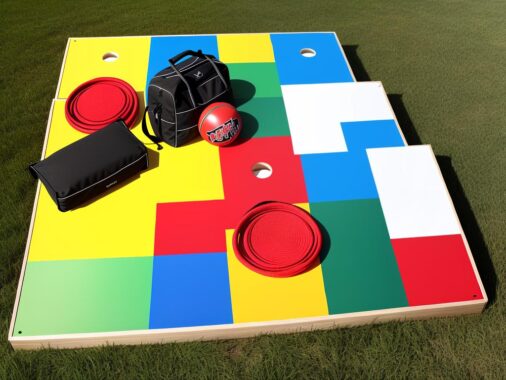Getting enthusiastically involved in a game of Cornhole promises hours of weekend entertainment and friendly competition. In mastering this quintessential backyard game, it is essential to familiarize yourself with not just the crux of the game, but also the specificity of its rules and methodologies. The game capitalizes on strategic play, which widens its appeal beyond a simple game of aim and reward. First, a comprehensive understanding of the rules would give you a solid grounding. This involves grasping the stipulations surrounding equipment, the scoring system, the artistry of throw, and prohibitions that may cause a foul. Second, with the game’s rules in hand, conquering the art of Cornhole would require adopting effective on-board strategies and perfecting an array of throws to ramp up accuracy and escalate your score.
Understanding the Cornhole Game Rules
Understanding the Basics of Cornhole
Cornhole is a popular lawn game in America, typically played during summer barbecues, tailgating events, and other outdoor gatherings. It involves players taking turns tossing bags filled with corn kernels at a raised platform with a hole in the far end. The goal is to get the bag in the hole or as close as possible. Being avid enthusiasts yourself, follow the instructions below to understand the fundamental rules of the Cornhole game:
Required Equipment
To play cornhole, you’ll need two wooden platforms that are each 2 feet wide by 4 feet long. The platforms must be placed 27 feet apart from front edge to front edge, with an angled side leading towards a single hole. Each team will also require four corn-filled bags about six inches in size.
Scoring System
Scoring in cornhole is relatively simple. Here’s a breakdown:
- Landing the corn-filled bag on the board without it touching the ground first: 1 point. These are known as “woody” or “board” points.
- Throwing the bag through the hole: 3 points. These are known as “cornhole” points.
It’s important to note that the game is played with cancellation scoring. This means that points scored by one player cancel out those scored by their opponent. Only one player/team can score in each frame.
Throwing Process
Players take turns throwing bags until all bags have been thrown, which constitutes an “inning”.
- A coin flip typically determines who pitches first.
- The player who scores in the preceding inning pitches first in the next inning.
- If no one scores, the player who pitched first in the preceding inning pitches first in the next inning.
- Players must throw from their designated pitcher’s box, a rectangular area located on either side of the board.
Fouls and Rules
To keep the game fair and entertaining, adhere to the following rules:
- Players must not step beyond the front edge of the box during their pitch.
- Bags pitched when a player has crossed the foul line are considered “foul bags” and make no contribution to the score.
- A bag that hits the ground and bounces onto the board is removed before resuming play.
Remember, it’s a game of skill and sight! May the best cornholer win.

Photo by austindistel on Unsplash
Effective Cornhole Techniques and Strategies
Introduction to Cornhole Strategies and Techniques
Cornhole is a simple, yet engaging outdoor game that has grown in popularity over the years due to its fun nature and strategic elements. The game involves tossing a bag filled with corn onto or into a hole in a wooden board that’s placed at a distance. To fully enjoy Cornhole and sharpen your skills, you should familiarize yourself with the important techniques and strategies that come into play. These include the slider, blocker, push, and air mail shots. This guide will give you a comprehensive overview of how to execute each shot and understand when to use them in the game.
Mastering the Slider Shot
The slider shot, also often called the spin shot, is one of the basic Cornhole techniques. This strategy involves spinning the Cornhole bag in a way that it slides up the board and into the hole. To execute this technique:
- Hold the bag flat in your hand, and preferably at the corner. You want to spin it for better control.
- Aim for the first third of the board. The bag needs room to slide and move towards the hole.
- Throw a low, hard toss with plenty of spin. The forward spin will help the bag slide up the board.
- Practice this throw consistently. The more you throw like this, the better your slider technique will become.
Perfecting the Blocker Shot
The blocker shot is a smart defensive strategy often used to prevent opponents from using the board. The aim is to land your bag directly in front of the hole, blocking it, and making it difficult for others to score. Here’s how you can perfect this technique:
- Hold the bag in a way that you can control where it lands.
- Aim for a spot right in front of the hole.
- Toss the bag with a higher arc to encourage it to land and stay put.
- Make sure you’re not tossing the bag too hard. The goal is to prevent it from sliding into the hole.
Using the Push Shot
The push shot is an offensive technique used to move your previously thrown bags into the hole or to push off your opponent’s bags off the board. Here’s how you do it:
- Aim at your blocker bag or opponent’s bag.
- Throw your bag with more force to give it the power to push other bags.
- Try to keep your throw low and flat, to preserve momentum and push the bag straight.
Executing the Air Mail Shot
The air mail shot is one of the most difficult techniques in Cornhole. It involves throwing the bag in a way that it lands directly into the hole, without touching the board. This shot requires practice and precision, but here are some tips to get you started:
- Hold the bag firm so you can control its flight.
- Visualize the arc of the throw in your mind. Throw the bag in such a way it lands directly into the hole.
- Start your throw lower and launch it higher, again this is a high arc shot.
- Practice, practice, practice. The air mail shot is not easy to master, but with consistency and repetition, you’ll improve over time.
Each Cornhole technique plays a crucial role in the game. Learning and mastering these techniques, understanding when to use them, and implementing strategy can transform a casual Cornhole player into a formidable competitor. As with any game, a combination of practice, skill, and strategy is key to success.

Photo by austindistel on Unsplash
Mastering the excitement that is Cornhole goes beyond a basic understanding of game’s rules. It involves a commitment to improving one’s strategic play and harnessing the perfect throw technique. By practicing on throws like the slider, blocker, push, and air mail shots, you can ensure that this quintessentially American game remains a source of limitless entertainment and thrill. Whether you’re on a beach, in the park, or in the comfort of your backyard, Cornhole epitomizes the balance between skill and fun that has, and will continue to, make it a favorite pastime.
Frequently Asked Questions about Mastering Cornhole Game
A: Cornhole, also known as bean bag toss or bags, is an outdoor game where players take turns throwing bean bags into a raised wooden platform with a hole.
A: In Cornhole, two teams of players take turns tossing bean bags towards the opposing platform. Landing a bag on the platform scores points, and sinking a bag in the hole earns more points.
A: Cornhole can be played with 2 or 4 players, making it a versatile game suitable for casual play or competitive tournaments.
A: Yes, Cornhole is a game that can be enjoyed by players of all ages, offering a fun and social outdoor activity.
A: To play Cornhole, you need two raised wooden platforms with holes and sets of bean bags for each team. The game is typically played on a grassy surface.
A: Absolutely! Cornhole is well-suited for backyard play, and it can also be enjoyed at parks, beaches, and other open spaces.
A: The duration of a game of Cornhole can vary depending on factors such as the number of players and the agreed-upon points. On average, a game can take around 15 to 30 minutes.
A: Yes, mastering techniques like the flat throw, the airmail, and the slide shot can improve accuracy and increase your chances of scoring points.
A: Yes, many communities have Cornhole leagues and clubs that offer organized play, tournaments, and opportunities to compete with other players.
